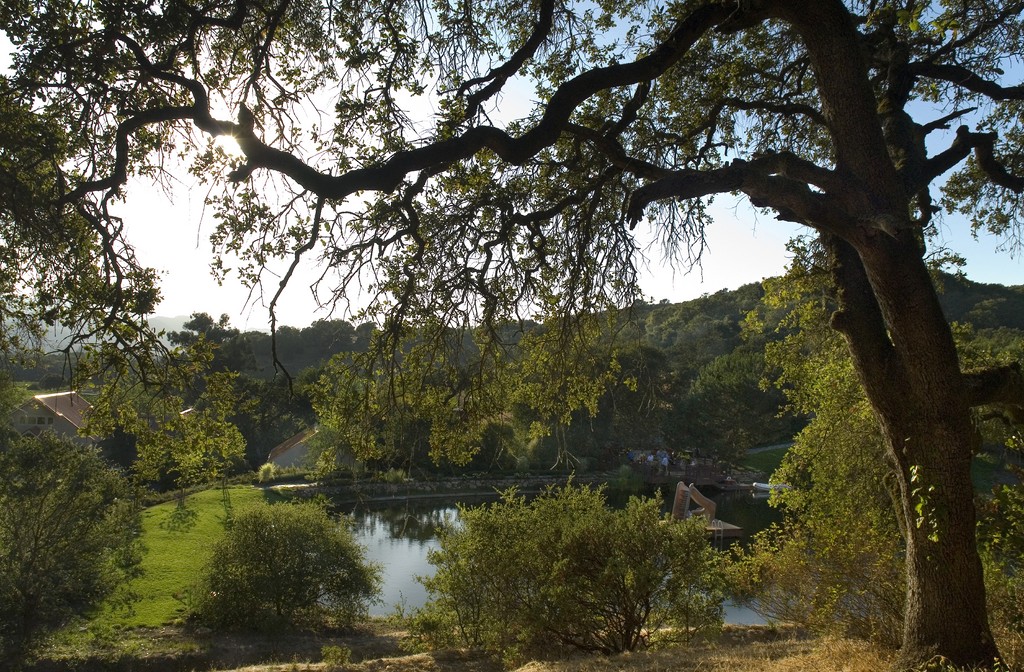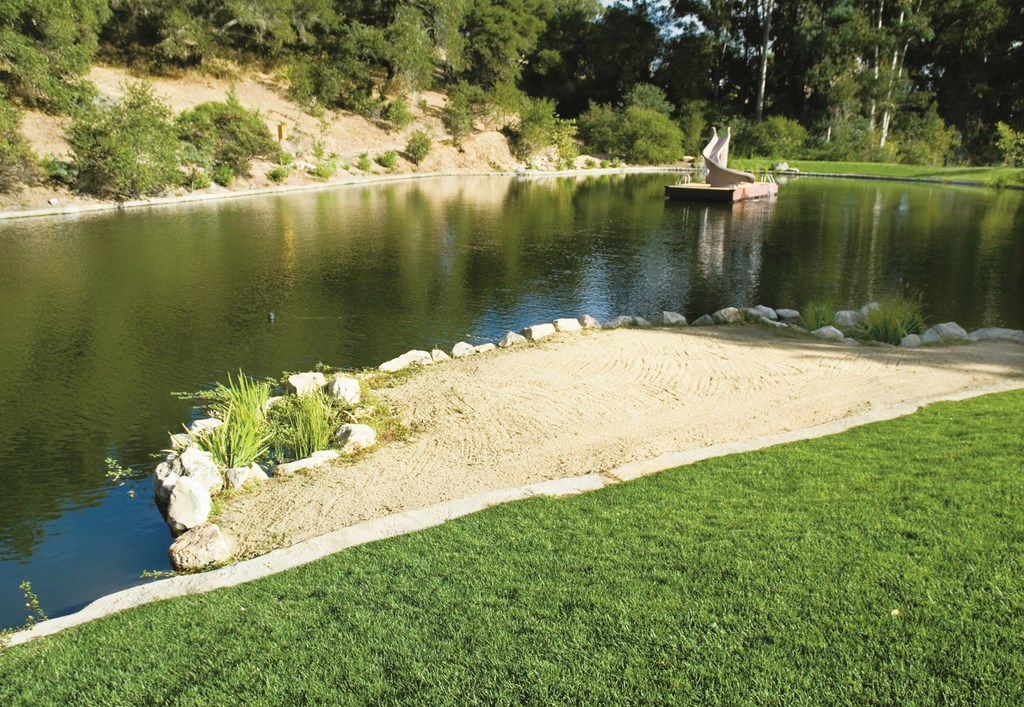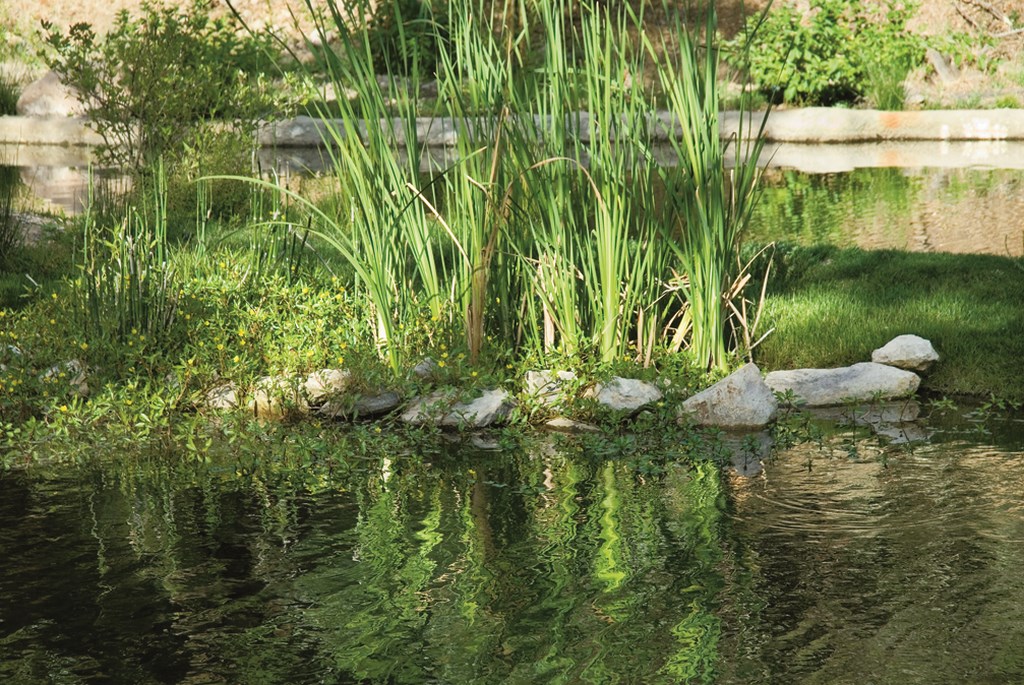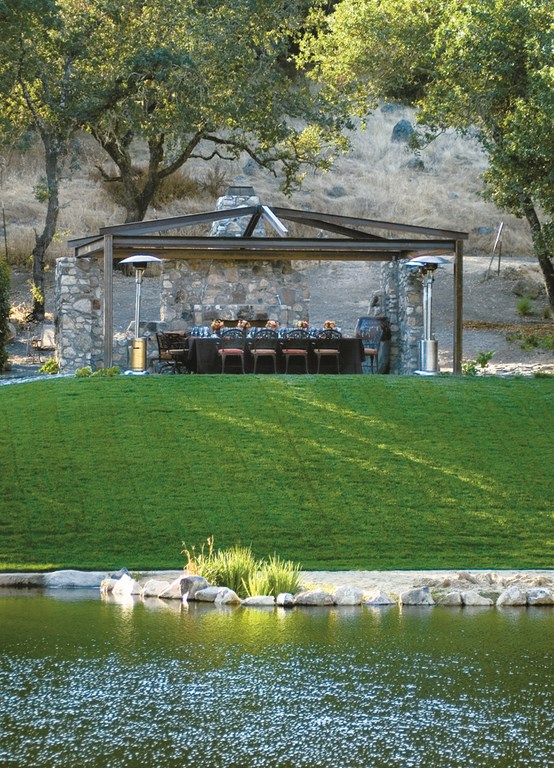Welcoming Waters

Every so often, a project comes along that evolves as it rolls along, and what starts out as one set of tasks and parameters morphs to become something entirely different before it’s through.
That was certainly the case on this residential-lake project: Located in the hills above Napa Valley, Calif., the job put us in touch with affluent, intelligent, fun-loving clients who had initially contacted us about the straightforward restoration of a dying lake located at the base of a ravine beset with unchecked plant growth and rattlesnakes.
None of that was new to us: We at Aquatic Environments of Alamo, Calif., are often called upon to tackle horrendous water-quality issues with bodies of water across a wide spectrum of property types, watershape sizes and functional profiles. Before we were finished here, however, the scope of work had grown beyond remediation to include creation of an amazing oasis for entertaining, swimming, fishing and observation of the seasonal rituals of geese.
Large-scale residential lakes are rare enough. Working with one that took such a focus on wildlife, fun and enjoyment – especially with an acre and a quarter of surface area – was a particularly satisfying challenge.
GOOD FOR THE GANDERS
When we arrived on site, the water was a complete mess.
Choked with emergent plants, algae and impenetrable murkiness, the only thing it had going for it from the homeowners’ standpoint was that it served as the spring home to a gaggle of Canada geese that showed up every March and hung around until about July.
Beyond that, it was an eyesore. It would fill up with runoff during the winter and draw down as the summer months wore on to become little more than a foul bog by the time the weather started cooling off again. Even though it was a mess, however, we all saw from the start that it had the potential to become something very special. Fortunately, the owners shared that vision and were willing and able to devote the budget to the process to make it all happen – and then some, as it turned out.
| Our initial aim was to heal a sick body of water – a mission we accomplished by installing a huge liner and a new circulation system that allowed the lake to thrive. It has always been artificial, so there wasn’t a huge priority on literal naturalism; instead, we sought to balance safety for those who would use the water with a generally natural look and a visual connection to the historic home and its surroundings. |
In its downtrodden state, the lake was completely out of step with the rest of the property, which features an historic, 1850s-vintage estate home, groves of wild oak trees and, of course, a multi-acre vineyard. The site is a bit unusual in that the house sits below the lake, separated from it by a large earthen bank or dam. The lake itself sits in an elevated ravine, surrounded by steep slopes.
The home’s history is even more unusual. As the story goes, the ten-acre estate was known in its earliest period as “Robbers’ Roost” – the hideout for a gang of stagecoach bandits. Only a portion of the original structure remains, but all subsequent additions (and there have apparently been several) have all remained true to the spirit and style of the original construction.
From the standpoint of designing upgrades to the lake and its surroundings, this traditionalist, history-preserving sensibility would play a major role in determining aesthetic decisions we would need to make as the work moved forward and expanded in scope. In the early stages, however, our entire concern was about helping the troubled water become a viable habitat once again.
That initial work was actually quite simple: We finished dewatering the lake, excavated and shaped the bottom and then stripped the surrounding area down to the rocky material found just beneath the thin layer of topsoil.
ACCESSIBLE CONTOURS
Once the initial clean-up work was done, the project became much more interesting, especially along the edges: The owners have two small children who were to be using the lake for swimming and fishing, so we’d decided to fashion what amounts to a safety ledge around the entire perimeter.
Although quite old, the lake had always been artificial, and one side had been cut into a rock slope many years ago. This section of shelf creation was tough going and required the removal of tons of rock material. Moreover, we had to make certain the slope remained stable as we worked and that we didn’t alter the site in a way that would create erosion problems later on.
| Once the lake was revitalized, the owners began getting all sorts of ideas about how it might be augmented for amusement of the entire family. First came extension of an existing deck out over the water (for entertainment purposes as well as fishing), then a raft/island for the kids, then a beach/shallow-entry area – definitely great for the kids but another great fishing platform, too. |
The ledge itself is set at 18 inches below the mean waterline and extends out two-and-a-half feet. The bottom then drops off at a 3:1 slope to about 15 feet at the deepest point. The idea is simple: If someone happens to fall off the edge and into the lake, it won’t be into deep water: The shelf has knee-deep water, and the area just beyond slopes quite gradually toward the lake’s center.
(This is an element we install on lakes and ponds for golf courses all the time: Duffers are notorious for stepping into the water to retrieve errant shots.)
The effort required to cut the ledge was well worth it from both the clients’ perspective and mine: Aquatic safety is a priority for any body of water, be it a lake, a swimming pool or a waterfeature – especially in places where small children live or play. In this case, we knew the lake would be used for swimming and other activities, so the ledge was the only sensible choice. It also provides easy access for people cleaning debris from the lake and gave us areas where we could easily set up planting pockets on the margins.
To handle excess rainfall, we set up an area along one end of the lakeshore where water can spill over a broad weir into a streambed that runs only when there’s enough water that the lake tops the weir. This prevents flooding and has the added benefit of providing a collection point for easy removal of floating debris and organic matter.
Once these basic necessities were accommodated, things started to loosen up creatively: We used the spoils from the excavation, for example, to create a new elevated pad as an observation point overlooking the lake and terraced other areas to serve as platforms for various plantings and hardscape touches.
As our work progressed, the owners approached us as well with the thought of extending an existing wooden deck near the lake out over the water for fishing and entertaining. We were still at a point in our work where accommodating this idea was easily possible: All we had to do was sink four reinforced-concrete piers into the lakebed to support the cantilevered structure.
CLEAR TO THE BOTTOM
As is true with all of our projects, water quality and clarity were top priorities. In this case, however, I had special concerns because of the way the property is situated, with steep, surrounding slopes that caused rainwater and huge amounts of fertilizers and organic matter to accumulate in the lake. If not handled properly, these periodic surges could create enormous problems.
To ensure quality water here, we installed a large, down-flow biological-filtration system in the deepest part of the lake.
This involved installing a grid of perforated manifolds across a 5,000-square-foot area and encasing them in a gravel medium topped with cobble. The water column is pulled down through the gravel bed, in which bacterial colonies perform their biological-filtering function. The filtered water flows to plumbing and is reintroduced via a series of sub-surface diffusers placed around the lake.
| The immense size of the lake and its liner made the prospect of filling the bottom with gravel a practical impossibility via conventional means. Luckily in this case, the way we’d built the edges of the lake made it possible to bring in heavyweight assistance in the form of this ‘rock slinger,’ a conveying system that made relatively short work of a huge job. |
Given the topography surrounding the lake and its rock-bound setting, there was no affordable (or feasible) means of installing the usual sub-grade vault and pump system. Instead, we chose a modified aerator pump to drive the circulation system, mounting it directly on the bottom of the lake. Manufactured by Aqua Control (Spring Valley, Ill.), the custom-designed unit was engineered to achieve our required turnover and flow rates.
Yes, this means servicing the pump will involve our dive crews, but our experience with these types of submersible pumps and aerators has shown us that they are extremely durable and reliable, so we felt right at home with this approach – even though it was the first we’d ever designed for such an application. Another benefit: The circulation system is entirely self-contained within the lake, so there are no plumbing penetrations of the “shell.” That’s a big plus given the rocky terrain.
Jumping ahead to the start-up phase for a moment, we’d gone out of our way to set up realistic expectations for the water quality during the first year of the revamped lake’s operation.
Typically, it can take up to a year for a lake this size to “settle out” or get clear and clean, even when everything is dialed in perfectly and working properly right from the start. I was shocked in this case, because we were able to establish almost perfectly clear water within the first couple of months – a wonderful surprise, because we completed our work early enough in the spring that our clients were able to enjoy the water without compromise during it’s first summer of operation.
CONSTRUCTION DYNAMICS
Doubling back to the installation, we lined the lake with a 30-mil PVC liner that came in five huge pieces. We fitted special sleeves over the deck/pier piles and “welded” the liner at the seams and those points to ensure a durable seal, then anchored the liner at the edges with the gunite we used to form the safety shelf before covering the entire underwater surface in gravel and cobble.
Given the size of the vessel and it’s huge submerged surface area, just adding the required volume of gravel and cobble proved a challenge. To get the job done, we used a special rig known as a “rock slinger” – that is, an extended, flat conveyor system that reached out over the lake in much the same way the boom arm for a concrete pump does. We fed stone into a huge hopper and swung the conveyor back and forth across the lakebed, effectively pouring the rock into place.
This work was facilitated by the fact that we’d decided to create a flat stone edge at the waterline around most of the lake’s perimeter. The original slope was just a bit too steep for safety and comfortable access, and this broad shelf offered a clear, easy transition into the water as well as secure footing all the way around the lake.
Furthermore, although it’s not a naturalistic look, it was in keeping with the thought that we wanted the “hand of man” to show through in what we were doing – beyond which it was our goal to make our work look as though it had been completed generations earlier. The result is a beautifully functional stone edge that works visually as well.
Getting into the spirit of things as the project unfolded, the owners began adding wrinkles that kept us busy. During construction, for example, they decided they wanted a beach entry on one end of the lake. We obliged them with a sloping gunite structure we fitted with some planting areas and filled in with a truckload of sand. Here again, our work offered both fun and increased safety.
Next, they became more and more infatuated with the notion of “decking” the lake out for fun, so they asked us to create a floating island/dock structure in the center of the lake. This was to be a swimmers’ destination – a place for relaxation in a relatively isolated spot.
The 20-by-20-foot island features an aluminum frame topped by a composite decking material made by Trex (Winchester, Va.) that we coated with six inches of rubberized, non-slip playground-surfacing material. There’s an eight-foot plastic slide that has its own self-contained water pump and switch, and the whole structure is buoyed by standard marina-style floats and secured via steel cabling to four large concrete anchors. These anchors are set almost directly beneath the island so that nobody diving off the edge has any chance of hitting or becoming tangled in a cable.
ADDING TO THE FUN
Now the adults started considering their own needs and desires. As mentioned above, they’d decided fairly early on to extend an existing wooden deck out past the water’s edge – a beautiful, cantilevered structure that now places our clients and their guests right at the heart of the setting. We again used Trex decking material to finish the structure we built atop the piles, and there’s now a 50-by-25 foot waterfront deck outfitted benches, safety railings and low-voltage lighting.
| What started out as a basic lake-restoration project eventually grew through participation of imaginative clients to a point where there were no real limits when it came to finding ways to facilitate fun in and around the water. Whether it was for the grown-ups in the form of a superlative dining pavilion and fireplace up on a hill we created or for the kids as a water-bound play platform, the emphasis shifted to fun once the clients recognized the space’s potential and our ability to makes their ideas into reality. |
Another mid-project addition was a separate dining and outdoor fireplace area. Located just upslope from the shoreline, this area has been made to look like a partial ruin that’s been restored as a dining space. An overhead I-beam structure is supported on four stone pilasters made to look like components of an old building – an effect made convincing through use of indigenous fieldstone material found around the property.
Now a large fireplace/hearth/chimney structure faces the lake, creating a visual destination from several prospects – a beautiful touch that harmonizes with the historic motifs of the overall property and one we understand has already seen a great deal of use.
Had we been charged with fashioning a body of water that would appear completely natural, many of these features – the stone edge, the floating island, the safety shelf, the big deck – would not have been appropriate. In this case, however, the owners wanted a body of water that would be inviting and fun for their children and any guests who had occasion to approach the water.
Soon after we finished our work, the lake was stocked with Bass, Bluegill and Catfish and immediately became home to scores of local birds, insects, reptiles and more. The upshot is that, however well it serves as a man-made setting for recreation and play, it also serves as a terrifically natural space – one that welcomes all who come near it.
George Forni is president of Aquatic Environments, an Alamo, Calif.-based design, installation and service firm specializing in lakes, ponds and other large waterfeatures. He started his career in the waste- and reclaimed-water industry in the mid 1980s. Before long, he became project manager for an aquatic service firm, for which he managed a number of projects in conjunction with the U.S. Army Corps of Engineers as well as in other regulatory agency-controlled jobs. His company now focuses mostly on the needs of large commercial clients in the Western United States.





















